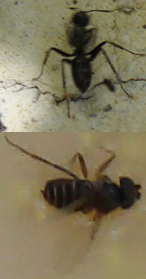Diptera.info :: Identification queries :: Diptera (adults)
|
Phoridae parasitoid of Camponotus vagus (Microselia? Pseudacteon?)
|
|
| Benus |
Posted on 13-01-2012 04:52
|
|
Member Location: London, UK Posts: 26 Joined: 11.01.12 |
Hi! I'm trying to identify this guy since the summer of 2000! Is a parasitoid of ants of the species Camponotus vagus. Max lenght 2mm, very agile and fast flyer. Spotted in Tuscany, Italy, from the sea to high hill. It is attracted by large number of busy workers and after following one for a while it perch on the abdomen (it normally prefer the lower side) and then lay his egg(s). The reaction of the worker is to go mad and try to remove it with the legs or the jaws. The closest workers get normally alarmed by this behaviour. I've noticed that the colonies heavily affected by this fly are affected by the CBPV "Chronic bee paralysis virus" as well, but I don't know if there are relations since the CBPV is known to be carried by mites (anyway I've never spotted mites on a C.vagus). When a colony is infected there are many dead workers around the nest, they lay in a unusual posture and if touched they easily lose the head. I guess it belongs to the Phoridae family, I've found some tred in this site but nothing related to C.vagus. Can anyone help me? Benus attached the following image:  [31.31Kb] Edited by Benus on 13-01-2012 14:15 |
|
|
|
| Paul Beuk |
Posted on 13-01-2012 08:50
|
|
Super Administrator Location: Netherlands Posts: 19403 Joined: 11.05.04 |
It is a phorid. BRian Brown is your man to tell more.
Paul - - - - Paul Beuk on https://diptera.info |
| Dieter |
Posted on 13-01-2012 09:35
|
|
Member Location: Munich, Germany Posts: 114 Joined: 15.04.07 |
Great observations! With this biology and from what can be seen from the (poor) foto it is either a Microselia or a Pseudacteon. Dieter |
|
|
|
| Benus |
Posted on 13-01-2012 14:01
|
|
Member Location: London, UK Posts: 26 Joined: 11.01.12 |
Thanks guys, I'm sorry for the poor quality of the photo but I haven't the right equipment for these small specimens, anyway I'm grateful for your advices. |
|
|
|
| Jump to Forum: |













